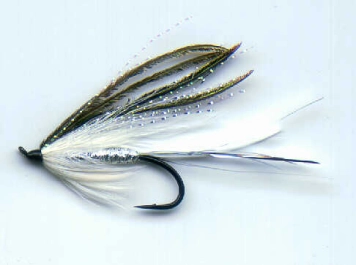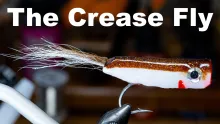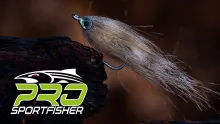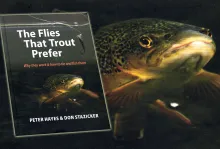Part wet fly and part streamer, it has all the obnoxious flash of a Mepps spinner in the water, and it's just as effective.
Part wet fly and part streamer, it has all the obnoxious flash of a Mepps spinner in the water, and it's just as effective.
I'm not one to jump onto the "hot new fly" bandwagon, but this particular fly caught my eye the very first time I saw it ("Fly Tyer", Volume 1 Number 1). Dan Blanton's "Fatal Attraction". Aptly named. As soon as I saw it, I knew it had to become part of my arsenal.
Here's the basic recipe:
| Hook: | I prefer an up-eye salmon hook like a Mustad 36890 or a Tiemco 7999 |
| Tail: | Flashabou, as long as the hook shank |
| Body: | Diamond braid, same color as the tail |
| Hackle: | Long soft hackle wound as a full collar |
| Wing: | Bucktail between two layers of krstal flash, tied in front of the hackle and reaching to the mid point of the tail |
| Topping: | Several strands of plush peacock herl |
Given the materials involved, the only limiting factor to the variety of patterns is your imagination. Here are a few of my favorites.
Black and Orange:
Gold tail and body, black hackle, orange bucktail between gold and pearl krystal flash
Fire Tiger:
Copper tail and body, chartreuse hackle, orange bucktail between pearl and peacock krystal flash
White:
Silver tail and body, white hackle, white bucktail between silver and pearl flashabou
The fly is actually quite easy to tie:
- Attach the thread behind the eye and wrap to the bend. Tie in several strands of flashabou about a shank length long.
- Move the thread to the front of the hook and tie in a length of diamond braid. Leave plenty of room for the hackle and wing.
- Wind the diamond braid to the tail and back to the eye for a doubled body, just as you would for any tinsel body. Trim the excess.
- Select a hackle that is soft and has barbules that will extend from the tie in point almost to the point of the hook. Fold the hackle and tie it in by it's tip. Make a few turns and trim the excess to complete a full hackle collar that's slanting slightly rearward.
- Tie in the first layer of krystal flash in front of the hackle.
- Tie in the layer of bucktail on top of the krystal flash.
- Tie in the final layer of krystal flash on top of the bucktail.
- Tie in the peacock herl topping on top of the final layer of
- Build a neat head and apply a coat of thin head cement to seal the wraps.
- Finish the head with epoxy or a couple coats of a thick, high gloss head cement.
bucktail.
A few notes about materials and proportions:
-
Double the tail
I make sure I "double" the flashabou tail to improve it's durability. Say I want a tail that's comprised of 20 strands of flashabou. I snip ten strands out of the bundle and tie them in at the bend of the hook, with the longer "waste" ends extending beyond the hook eye. I make a couple wraps just to hold them in place, then fold the long ends back over the bend of the hook and make several wraps over this doubled section. I then trim the
tail to length (usually at an angle). This "doubling" of the tail helps to keep the flashabou securely tied to the fly so that none of the strands are accidentally pulled out when you're removing the fly from a fish's mouth. It's slippery stuff, and this will help you any time you tie in flashabou, not just for this fly. I do the same for the krystal flash wings. -
Smaller sizes
For smaller sizes (6 and smaller), I like to use strands of metallic "Lite Brite" in place of the flashabou. It is softer and offers more movement than flashabou when scaled down to a small fly. "Fire Fly Tie" is also a good substitute for the flashabou. I don't find it to be as reflective, but it is much soft than flashabou and works will in short lengths.
-
Hair variations
Instead of using bucktail, any natural or synthetic hair can be used as long as it does not cause bulk either in the wing itself or in the head where it is tied off. I've used a soft Kid Goat hair in bright orange for smaller flies, and I would like to use some dyed Arctic Fox if I can ever find some that I can afford and is dyed to the appropriate colors. It is even possible to create a wing with a mottled effect, using such hairs
as squirrel tail, gray fox, or badger. To date, I have stuck with the traditional bucktail for my fishing flies. -
Sparse wing
The wing itself is quite sparse. A few strands of krystal flash surround just a dozen or so hairs from the bucktail. By far, the majority of the wing is comprised of the peacock herl topping.
-
Hackle choice
I like hen saddle for the hackle, as it is very soft and mobile in the water. In the absense of the appropriate hen saddle, any soft hackle will work provided the barbs are long enough and the hackles is on the soft side. Strung hackle works well as do the body feathers sold as Hoffman's "Soft Hacke w/ Chickabou".
-
Longer wing
By tying in the wing in front of a full hackle collar, you can make the wing extend beyond the bend of the hook without it fouling during casting and fishing. It's very rare that the wing will get stuck in the hook bend. Very rare indeed, as the hackle on top of the hook keeps the wing propped up and out of harm's way.
-
Adding weight
The fly as tied above will sink, the rate depending on the style and thickness of the hook chosen and the amount of materials used when tying the fly. If you want a fly that will dive to the depths, wrap a layer of lead under the diamond braid body.
Tail is the key
I believe the tail is the key to this fly. That twinkling, winking, shining flashabou tail. Dan Blanton says he feels it is the fly fisher's answer to the whirling blades of a spinner. I tend to agree, although we know the vibrating nature of a spinning blade does as much to attract the fish as the shine. Regardless, those blinking strands of mylar will attract the eye of a hungry fish from quite a distance and will result in some explosive strikes.
Down and across
When I fish it in rivers and streams, I always fish it down and across with a classic "wet fly swing" type of action. The fly has so much built in movement that it is unnecessary to diddle around with strips or rod jiggles. Just let the fly flow along in the water and the current will bring it to life. It may help to hold the rod up so that there is a bit of give, otherwise you will be risking breakoffs if the fish really nails it.
Built in action
When fished in lakes and ponds, the fly still has enough built in action that violent strips are not required. That flashabou tail will move and flutter with just the slightest hint of water movement. However, I find small two to four inch random strips will keep the fly moving at a consistent depth and will improve the overall action and effectiveness of the fly, with several pauses to let the fly sink a bit. Image a baitfish that is having a bit of difficultly swimming - that's what I try to represent when fishing this fly in still waters.
Many species
The Fatal Attractionis certainly is not a 'one species' type of fly. Dan tied it first for largemouth bass, I believe, but has used it for lake dwelling trout and even saltwater species. Myself, I've used it for river trout and bass as well as the species of salmon that run out of Lake Ontario each fall. This past year, I sent a sample to my friend in Nova Scotia who proceded to hook and land an Atlantic Salmon with the fly (black and orange version). By varying the size and hook type, this fly style can be adapted to all manners of fly fishing.
It's found it's way into all of my fly boxes as well as my heart. I have confidence when I tie on the fly - and we all know how much of a difference that can make.
Try one. I think you'll be a believer.
- Log in to post comments








